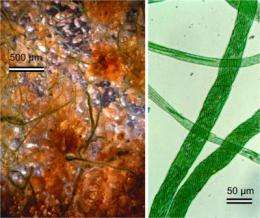Bacterial 'ropes' tie down shifting Southwest

Researchers from Arizona State University have discovered that several species of microbes (cyanobacteria), at least one found prominently in the deserts of the Southwest, have evolved the trait of rope-building to lasso shifting soil substrates.
These tiny filamentous cyanobacteria are typically found in the environment as multicellular single strands or threads. Though known as pioneers in the biostabilization of soils, scientists have long puzzled over the factors that control and promote the twisting of some species' individual threads into thick cords sometimes inches in length.
Ferran Garcia-Pichel and Martin Wojciechowski, researchers in ASU's School of Life Sciences in the College of Liberal Arts and Sciences, examined genetic markers of rope-makers, relating them to shear stress, soil particle size and friction velocity (linked to erosion) to develop an understanding about the relationship between bacterial behavior, evolutionary fitness and environmental effectors.
The results of their study, published Nov. 17 in the journal Public Library of Science (PLoS) ONE, revealed that rope-building cyanobacteria, typically found in fine, sandy desert soils, marine subtidal stromatolites and coastal sand flats, are able, because of their larger size, to hog-tie sand grains and resist eroding wind and fluid at velocities that would typically wash away their thread-like relatives.
"While forming thick ropes seems to have apparent disadvantages, such as limiting access to light or nutrients, bundling-up actually turns out to be, literally, like throwing your neighbor a life-line," Garcia-Pichel says.
Wojciechowski adds: "These microbes rope-building attributes have added to their success as the true Western pioneers."
Garcia-Pichel believes that it was environmental effectors that led to the selection of genetic traits to promote rope-building. Phylogenetic analyses performed by the researchers have further shown that the evolution of the trait occurred separately in three different genera; an example of convergent evolution, rather than a tie to a single common rope-building ancestor.
In the desert, the initial stabilization of topsoil by rope-builders promotes colonization by a multitude of other microbes. From their interwoven relationships arise complex communities known as "biological soil crusts," important ecological components in the fertility and sustainability of arid ecosystems.
Source: Arizona State University (news : web)

















